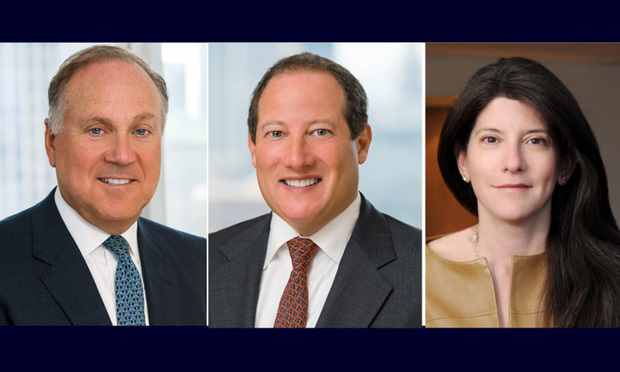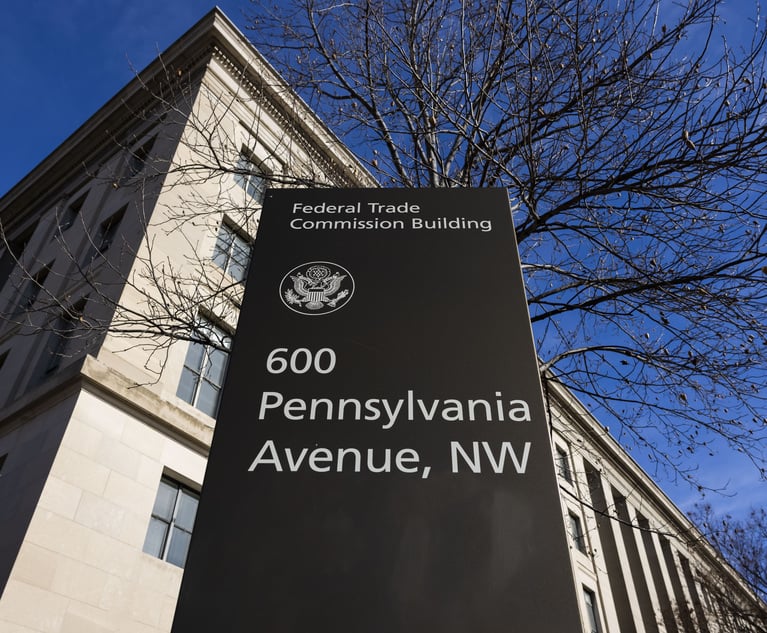Skadden Securities Team Sees 'Event-Driven' Class Actions as Continuing Trend for 2019
The firm's litigators see class-action increases and the fallout from the U.S. Supreme Court's 'Cyan' decision continuing to have an impact in 2019.
January 04, 2019 at 03:31 PM
5 minute read
 Skadden partners Jay Kasner, Scott Musoff and Susan Saltzstein.
Skadden partners Jay Kasner, Scott Musoff and Susan Saltzstein.
Event-driven securities litigation led to another big year for class actions in 2018—a trend that will likely continue to develop in unique ways in 2019, according to a trio of top securities litigators at Skadden, Arps, Slate, Meagher & Flom.
Head of the group, Jay Kasner, and co-deputy heads, Scott Musoff and Susan Saltzstein, pointed to a number of key trends in the securities litigation space that made 2018 a year of note, while 2019 could see the maturation of some big issues for litigators in the space. Event-driven class actions is one case in point, as Kasner noted.
“Even though the credit-crisis litigation has slowed, over the course of 2018 there has been an increase of what is loosely defined as event-driven litigation, which has become a very significant predicate for securities class actions and derivatives suits,” Kasner told the New York Law Journal.
These event-driven cases have been brought following a variety of corporate events, such as becoming enmeshed in a government investigation or allegations of more general unlawful conduct, according to Kasner. Suits against foreign companies whose securities are traded on U.S.-based exchanges have been a significant component of this trend, he added.
This overall upward trend comes without the kinds of “across-the-board stock drops” such as the bursting of the internet bubble or the collapse of the housing market.
“You are seeing these increases in securities litigation in the face of unprecedentedly strong financial markets,” Kasner said. “You can imagine a scenario where—crystal-balling into the future—the stock market were to weaken a significant amount, driving additional securities litigation, then really you could be looking at dramatically more filings than you have now by the end of the year, were that to occur.”
One of the areas of interest heading into 2019 will be the continued development of securities litigation in the wake of the U.S. Supreme Court's March 2018 decision in Cyan v. Beaver County Employees Retirement Fund. As was predicted by some during the course of the litigation, securities actions that previously were limited to the federal courts are now seeing a wave of parallel or substitute filings in the state courts, particularly in New York.
The effect, according to the Skadden team, is a whole new way of handling securities cases, in courts that have yet to develop the same level of sophistication to deal with them.
“Plaintiffs' lawyers are attempting to litigate those cases as if the [Private Securities Litigation Reform Act] had never been passed,” Saltzstein said.
The flood of '33 Act class actions in the state system is forcing litigators to address new issues that will only continue to develop in the coming year, she said.
“That poses a number of issues that are being grappled with by New York state courts for the first time addressing what are otherwise federal securities law issues that would typically be decided by the federal rather than the state courts,” Kasner said.
The divergent paths in state versus federal courts also set up possible future conflicts between the two that litigators will have to navigate going forward, Saltzstein noted.
“We could have a situation where the New York Court of Appeals could come out with a ruling that diverges from what the Second Circuit has to say,” she said. “It's an odd setup, and it's real world—we're seeing an increase in state court filings and litigating them.”
Another issue worth being on securities litigators' radars remains actions in the cryptocurrency and cybersecurity space, Musoff said. Quickly becoming a perennial issue, hacking and other cybersecurity issues will continue to require monitoring for potential litigation, while federal regulators are continuing to step up their involvement in this area in the hopes of heading off issues before they arise, according to Musoff.
On the crypto front, he anticipated suits that dig into the substantive issue of whether cryptocurrencies are currencies or securities will percolate up through the system soon.
The Me Too movement's social impact may extend into the courts in 2019 as a source for securities litigation, according to Saltzstein. She pointed to a recent Southern District of New York decision In re Signet Jewelers Limited Securities Litigation, which denied a motion to dismiss a suit that included sexual harassment claims as part of a securities fraud lawsuit.
The decision, by U.S. District Chief Judge Colleen McMahon, appeared to diverge from rulings in other jurisdictions, as well as within the Southern District itself, where allegations relying on alleged statements in corporate policies were found not to give rise to an actionable securities claim. In Signet, the court found that statements within the company's corporate code at issue were “directly contravened” by allegations the company conditioned employment decisions “on whether female employees acceded to sexual demands,” the court found.
These types of suits are worth keeping an eye on for a potential change in how some federal courts are addressing the issue, Saltzstein said.
RELATED:
What 11 Ex-Big Law Partners' Financial Disclosures Revealed in 2018
SEC to Examine Cybersecurity, Digital Assets and Anti-Money Laundering Efforts in 2019
DOJ Steps Back From All-or-Nothing Approach for Cooperation Credit
This content has been archived. It is available through our partners, LexisNexis® and Bloomberg Law.
To view this content, please continue to their sites.
Not a Lexis Subscriber?
Subscribe Now
Not a Bloomberg Law Subscriber?
Subscribe Now
NOT FOR REPRINT
© 2025 ALM Global, LLC, All Rights Reserved. Request academic re-use from www.copyright.com. All other uses, submit a request to [email protected]. For more information visit Asset & Logo Licensing.
You Might Like
View All

Judge Denies Retrial Bid by Ex-U.S. Sen. Menendez Over Evidentiary Error

What Businesses Need to Know About Anticipated FTC Leadership Changes
7 minute readTrending Stories
Who Got The Work
J. Brugh Lower of Gibbons has entered an appearance for industrial equipment supplier Devco Corporation in a pending trademark infringement lawsuit. The suit, accusing the defendant of selling knock-off Graco products, was filed Dec. 18 in New Jersey District Court by Rivkin Radler on behalf of Graco Inc. and Graco Minnesota. The case, assigned to U.S. District Judge Zahid N. Quraishi, is 3:24-cv-11294, Graco Inc. et al v. Devco Corporation.
Who Got The Work
Rebecca Maller-Stein and Kent A. Yalowitz of Arnold & Porter Kaye Scholer have entered their appearances for Hanaco Venture Capital and its executives, Lior Prosor and David Frankel, in a pending securities lawsuit. The action, filed on Dec. 24 in New York Southern District Court by Zell, Aron & Co. on behalf of Goldeneye Advisors, accuses the defendants of negligently and fraudulently managing the plaintiff's $1 million investment. The case, assigned to U.S. District Judge Vernon S. Broderick, is 1:24-cv-09918, Goldeneye Advisors, LLC v. Hanaco Venture Capital, Ltd. et al.
Who Got The Work
Attorneys from A&O Shearman has stepped in as defense counsel for Toronto-Dominion Bank and other defendants in a pending securities class action. The suit, filed Dec. 11 in New York Southern District Court by Bleichmar Fonti & Auld, accuses the defendants of concealing the bank's 'pervasive' deficiencies in regards to its compliance with the Bank Secrecy Act and the quality of its anti-money laundering controls. The case, assigned to U.S. District Judge Arun Subramanian, is 1:24-cv-09445, Gonzalez v. The Toronto-Dominion Bank et al.
Who Got The Work
Crown Castle International, a Pennsylvania company providing shared communications infrastructure, has turned to Luke D. Wolf of Gordon Rees Scully Mansukhani to fend off a pending breach-of-contract lawsuit. The court action, filed Nov. 25 in Michigan Eastern District Court by Hooper Hathaway PC on behalf of The Town Residences LLC, accuses Crown Castle of failing to transfer approximately $30,000 in utility payments from T-Mobile in breach of a roof-top lease and assignment agreement. The case, assigned to U.S. District Judge Susan K. Declercq, is 2:24-cv-13131, The Town Residences LLC v. T-Mobile US, Inc. et al.
Who Got The Work
Wilfred P. Coronato and Daniel M. Schwartz of McCarter & English have stepped in as defense counsel to Electrolux Home Products Inc. in a pending product liability lawsuit. The court action, filed Nov. 26 in New York Eastern District Court by Poulos Lopiccolo PC and Nagel Rice LLP on behalf of David Stern, alleges that the defendant's refrigerators’ drawers and shelving repeatedly break and fall apart within months after purchase. The case, assigned to U.S. District Judge Joan M. Azrack, is 2:24-cv-08204, Stern v. Electrolux Home Products, Inc.
Featured Firms
Law Offices of Gary Martin Hays & Associates, P.C.
(470) 294-1674
Law Offices of Mark E. Salomone
(857) 444-6468
Smith & Hassler
(713) 739-1250







